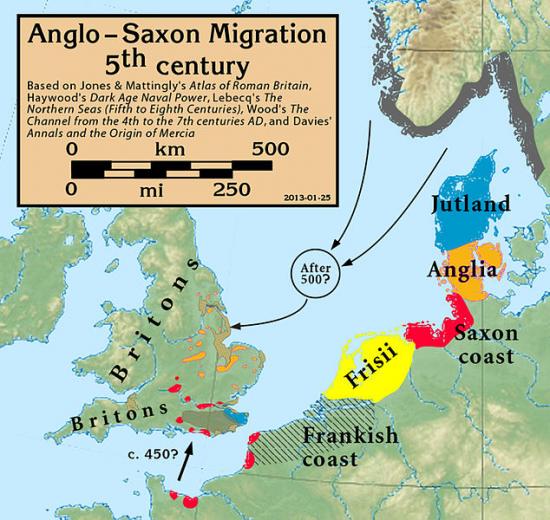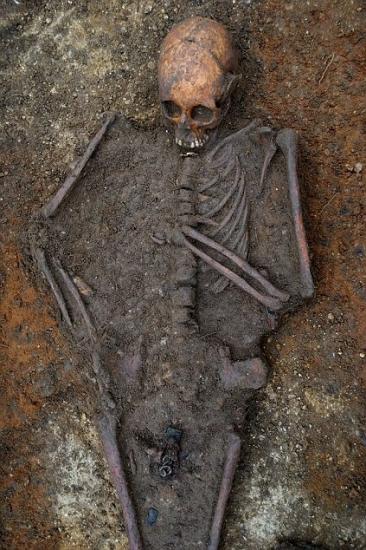Recently, I have been reading quite a bit about migration during the Early Medieval period. Traditional narratives of this period tend to argue that as the Roman Empire was declining in the late 4th and early 5th centuries, various barbarians groups from Germany and Eastern Europe began invading and raiding Western Europe. In England, this is portrayed as three groups, the Angles, Saxons and Jutes, entering the island after the Roman Empire left, and conquering the entire country. Once these barbarian groups had removed all traces of the empire, Western Europe was plunged into the Dark Ages.
Of course, more recent analysis and archaeological interpretation has shown that it wasn’t this dire, and perhaps wasn’t even that dark, culturally speaking. There is even question as to the extent of colonization, and whether the changes in the West were more due to internal processes rather than external migration. Various scholars have classified this period from being one of invasion and destruction, to replacement of a tired regime with new vital blood, to one where only a small elite of barbarians invaded and there was primarily continuity between the periods. We have something vital to the argument that may aid in determining the extent of migration- the physical remains of the people from this period.

Anglo-Saxon migration map, via Wikimedia
The mass migration of Germanic groups into England is known as the Adventus Saxonum, a term coined by Gildas, a 6th century British cleric who wrote the history of post-Roman Britain. However, the best characterization of the event was written by Bede, and in it he identifies three primary groups that migrated: the Angles, Saxons and Jutes. While we know that there was a major change in material culture during this period, the actual scale and manner of the migration is still highly debated. Cemetery analyses of this period have in the past focused on material culture as a way to determine who was native and who was a migrant, however, the problem is that materials don’t always indicate the ethnic backgrounds of an individual. Historic studies of these groups argued that cremation or burials with grave goods were indicative of immigrants, whereas simple inhumation burials were native Britons- a simplistic argument that has been proven wrong. As Anthony (1998) argues “cultures don’t migrate; people do,”.
Therefore, in order to learn more about actual migration, stable isotope analysis has been done at a number of early medieval cemeteries to determine who these individuals were, and perhaps learn more about migration. Increasingly, stable isotope analysis of the ratios of strontium, oxygen, and sometimes lead within skeletal remains is being used to determine where the individual is originally from. There is an assumption that the bones of individuals contain an isotopic composition similar to the geology and geographic area from which they originated.
There are two recent studies that use this technique to aid in the interpretation of the Adventus Saxonum using early medieval cemeteries from England. These include the Anglian cemetery at West Heslerton (Montgomery et al. 2005), and the Bowl Hole Anglian cemetery at Bamburgh, Northumberland (Groves et al. 2013). The West Heslerton Cemetery was in use from the late 5th to early 7th centuries, and was placed near a Late Neolithic and Early Bronze Age ritual site consisting of a hengiform enclosure, timber post circle, round barrows, and associated burials. The site had over 100 burials, and of these 33 were selected for stable isotope analysis based on the presence of Germanic artifacts that may indicate they were a migrant. Both children and adults were selected for sampling. The Bowl Hole cemetery is located near the famous Bamburgh Castle, and has a long history of use. The burials themselves were laid out in rows and there were a total of 91 discrete burials, though more burials were found in non-traditional burial locations across the site. The deceased population consisted of a demographic mix, and from this a sample of 78 individuals were selected for isotopic analysis. In both studies, the teeth were selected for sampling.

Anglo-Saxon Burial, bones somewhat intact, via Daily Mail
The analysis of the cemetery at West Heslerton revealed that there were two different groups of strontium isotopes suggestive of either different origins or different sources of food. The first group was reflective of the local geology, and would be more likely to consist of the native group. The second had ratios outside the normal range of the area and either consist of immigrants or imported their food. This second group isn’t necessarily Germanic, since the strontium range found could potentially be located in England, but there is a higher likelihood. Both groups had similar demography, which means the strontium difference wasn’t based on diet differences by age or gender. They also found that when comparing grave goods to strontium, those individuals with non-native strontium levels were more likely to have wrist-clasps and cruciform brooches, Anglian associated artifacts. There were not however differences in other grave goods or burial types that were differentiated by burial.
At the Bowl Hole cemetery, it was determined that the majority of individuals found at the site were non-local, and came from a variety of areas possibly attracted to the site due to its royal status. Some of the strontium levels are highly suggestive of immigration from Germanic and Scandinavian countries, although there is also a group from the site that corresponds with Mediterranean or Northern African origins. Like West Heslerton, sex and age was well distributed throughout the groups, suggesting that families were moving, not groups of elite males. In general, those identified as non-local were healthier and taller than the locals. A comparison of grave goods and burial patterns revealed no clear correlation between the immigrants and natives.
It is important here with these studies to recognize what Anthony said earlier, we are studying people not cultures. Immigration doesn’t necessarily mean that one is going to appear culturally different in the archaeological record. It also doesn’t mean that the native peoples won’t quickly adopt an immigrant culture. The way people are buried are reflective of their beliefs, ideologies, histories, and understandings of the body. All of these can change with migration, exposure to new ideas, and change in situation. While strontium allows us to determine who was local or non-local, it doesn’t necessarily mean that they were culturally different.
Works Cited
Montgomery J, Evans JA, Powlesland D, & Roberts CA (2005). Continuity or colonization in Anglo-Saxon England? Isotope evidence for mobility, subsistence practice, and status at West Heslerton. American journal of physical anthropology, 126 (2), 123-38 PMID: 15386290
Groves SE, Roberts CA, Lucy S, Pearson G, Gröcke DR, Nowell G, Macpherson CG, & Young G (2013). Mobility histories of 7th-9th century AD people buried at early medieval Bamburgh, Northumberland, England. American journal of physical anthropology, 151 (3), 462-76 PMID: 23737109
Anthony D. 1997. Prehistoric migration as a social process. In: Chapman J, Hamerow H, editors. Migrations and invasions in archaeological explanation. BAR international series 664. Oxford: Archaeopress. p 21–32.